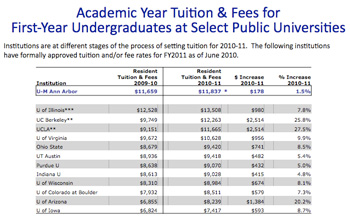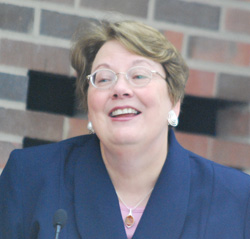UM Raises Tuition 1.5%, Budget Grows 6.75%
University of Michigan Board of Regents meeting (June 17, 2010): Budget presentations dominated the June meeting, the time of year when regents are asked to approve what have become inevitable tuition hikes for the university.
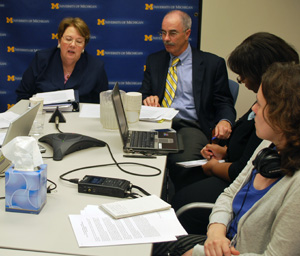
University of Michigan provost Teresa Sullivan, left, and vice provost Phil Hanlon brief the media about tuition rates immediately prior to the regents meeting on June 17. Hanlon will become provost when Sullivan leaves at the end of the month for her new post as University of Virginia president. (Photos by the writer.)
This year, with two regents dissenting, a tuition increase of 1.5% for in-state undergraduates was approved for the Ann Arbor campus. UM executives noted that it’s the lowest rate increase in 26 years – but if their projections for state appropriations prove too optimistic, they cautioned that they might need to return to request raising tuition later in the fiscal year.
University officials say they’re buffering the tuition increase by substantially adding to the amount of financial aid available to students – $126 million, up $8.3 million from the current year. They’re also launching a new “economic hardship” program, adding $500 in financial aid per year for up to four years for qualified students.
Tuition makes up a large portion of the general fund operating budget. For the Ann Arbor campus, a budget of $1.55 billion in FY 2011, which begins July 1, marks a 6.75% increase from FY 2010.
Regents also approved the FY2011 budget for the UM Hospitals and Health Centers – revenues are projected to top $2 billion for the first time during this year, with a $66 million operating surplus.
And UM athletic director Dave Brandon gave a briefing on the athletic department budget, though it doesn’t require regental approval. Projected revenues of $105 million includes $38.19 million from ticket sales, while the budgeted $100.3 million in expenses includes a $9.22 million debt service payment for Michigan Stadium renovations.
In addition to budgets, regents approved several construction projects, including a $56 million renovation of Alice Lloyd Hall and a $1.6 million repair of Burton Memorial Tower, which will close the landmark site – and silence its carillon – for about a year, starting in August.
Budget Overview
Tim Slottow, UM’s chief financial officer, began the budget presentations with an overview of the university’s financial status. The university has $13.8 billion in assets – both financial and in its physical plant – and $4.5 billion in liabilities, resulting in net assets of $9.3 billion.
In discussing UM’s liabilities, Slottow cited several threats to the balance sheet. “People often ask what keeps a CFO up at night,” he joked. “This is the list.” Future liabilities include deferred maintenance of buildings, retirement health benefits and increasing future debt liabilities, he said.
Other threats include unprecedented market volatility, which will continue, he said, as will volatility in energy prices, which have swing “wildly” up and down. But the one thing that never seems to go down is health care costs, he said – this year, those costs for UM have increased 2.8%, compared to a national average of roughly 10%.
He discussed efforts to endow the general fund – in FY 2010, the general fund was supplemented by $210 million from the endowment. That money is used primarily for scholarships, professorships and academic programs, Slottow said. Strategically, the move to endow more general fund activities began five years ago, and has included gifts to endow building maintenance and operations for facilities like the Stamps Auditorium and Kelsey Museum. The endowment for the general fund today stands at $213 million, he said, yielding annual revenue of $12 million. The university’s total endowment is an estimated $6.7 billion.
Slottow reviewed the physical plant of the Ann Arbor campus, as a reminder of the infrastructure that the university supports. That includes:
- 25 miles of roads and 4.5 million square feet of sidewalks, steps, and plazas
- 7 miles of utility tunnels and 150 miles of fiber optic cable
- 280 acres of parking lots/decks
- 32 million gross square feet of buildings and core infrastructure
- 601 buildings, 1,807 classrooms and instructional labs, 1,113 study rooms, and 6,125 research labs/rooms
- 540 elevators and escalators
- 14,000 trees and 12 million square feet of turf
- 100,000 network desktop computers
For all three campuses, the university employs 28,809 regular staff and 6,967 instructional, clinical and research faculty. Slottow pointed out that about 40% of employees will be eligible for retirement within the next few years, as will more than 50% of UM’s managers. They need to start preparing for that with leadership training, knowledge transfer and career development for a smooth transition, he said.
As of March 31, 2010, the university’s debt totaled $1.58 billion. Slottow said a prudent debt management policy has helped the university earn the highest possible credit rating from Standard & Poor’s – a triple-A. And soon, he added, UM’s provost will be the only living person to have worked as a senior executive for three universities with that rating: Texas, Michigan and Virginia. Provost Teresa Sullivan, who previously was executive vice chancellor for academic affairs at the University of Texas, will be leaving at the end of June to become president at the University of Virginia.
Tuition Rates, Financial Aid: Ann Arbor Campus
Provost Teresa Sullivan presented the FY 2011 general fund operating budget for the Ann Arbor campus, which included tuition rates and fees. [Regents had approved housing rates at their May 20 meeting – a 3% average increase in room and board.]
For the fiscal year beginning July 1, total general fund operating revenues are projected at $1.55 billion – up 6.75% from the current year. Sullivan cited several reasons for the revenue increase, including higher undergraduate enrollment and increased research funding. [Stephen Forrest, UM's vice president for research, had briefed regents on the latter topic at their Jan. 21, 2010 meeting.]
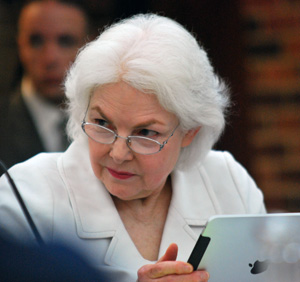
Julia Darlow was elected chair of the board of regents at their June 17 meeting, succeeding Andy Richner. She's holding an iPad, which regents are starting to use as part of an effort to reduce paper documentation.
The budget assumes the university will receive $315.1 million in state appropriations. Given the state’s financial crisis, “there is the possibility that this assumption is too optimistic,” Sullivan said. She noted that since 1960, state support as a percentage of UM’s general fund has dropped from 78% to 20%. Conversely, tuition and fees accounted for only 20% of UM’s general fund in 1960 – today, it accounts for 65% of general fund revenues.
Sullivan also outlined the university’s cost containment efforts, noting that the budget assumes $39 million in cuts. Those cuts are coming from greater sharing of benefits costs with employees, the consolidation of information technology units, more efficient use of space, and reform of UM’s travel/hosting policy, she said.
Over the past seven years, Sullivan said the university has trimmed $159 million in recurring general fund expenditures – and more cuts are to come. There are five task forces looking at ways to find further budget savings, as well as exploring ways to increase revenues. And a committee that’s examining the costs of retiree health benefits will be presenting its report in the next few weeks.
Sullivan said these efforts also involve reallocating resources to fund academic initiatives – for example, the FY 2011 budget includes expanded funding for the popular undergraduate research opportunity program (UROP). The budget also includes funding for 50 additional faculty hires, above the previously targeted 100 positions that UM plans to add. The new hires are in response to increased undergraduate enrollment, she said, and will make smaller class sizes possible.
The university is increasing its centrally awarded financial aid to $126 million – $8.3 million more than the current year. That’s in addition to financial aid that’s available from individual schools and colleges, Sullivan said. She also pointed out that some families are eligible for a federal tax credit for tuition – as much as $2,500 for families earning up to $160,000 (in a two-income household) or up to $80,000 for a single-income household per year.
In addition, UM has launched the “economic hardship” program, which will provide an additional $500 in financial aid to in-state students with family income in the $60,000 to $100,000 range. The grant will be renewable for up to four years, and will cost the university about $3.6 million over that period.
All of this set the stage for the recommended tuition increase: 1.5% for in-state undergraduate students, and 3% for non-residents. First-year undergraduates would pay roughly $11,837 in tuition and fees, or $178 more than the current year. Non-residents would pay $36,001, or an additional $1,064 per year.
The 1.5% increase is the lowest since 1984, Sullivan noted. [Last year, regents approved a 5.6% increase, with regents Julia Darlow and Denise Ilitch dissenting.]
Tuition rates for both in-state and out-of-state graduate students will go up 2.8% –or $498 per year for in-state graduate students, $1,000 per year for out-of-state students. A tuition decrease of 15.4% for doctoral candidates will keep tuition revenue neutral, Sullivan said, due to a new continuous enrollment policy that requires students to pay tuition throughout their candidacy. [Regents were briefed on that policy change, which has been controversial among graduate students, at their December 2009 meeting.]
Sullivan put the tuition increases in the context of peer institutions, noting that UM’s increase will bring its tuition rates to fourth among Big Ten universities. She also compared tuition for out-of-state students with a range of private universities, noting that UM tuition ranks near the bottom.
She ended her presentation with a caveat: If the state appropriations turn out to be lower than projected, the administration might return to regents to request a mid-year tuition increase.
Sullivan said the university takes very seriously its responsibility to students to keep tuition increases to a minimum. This budget does that, she said, while also ensuring continued quality.
Comments from the Regents
There was no discussion of the budget proposal, but several regents read prepared statements or made remarks before the vote was taken.
Julia Darlow, who voted against tuition increases last year, expressed support for the entire budget, but directed her remarks specifically toward the budget for the Ann Arbor campus. The limited tuition increase of 1.5%, coupled with significant increase in financial aid, show that the university is reaching out to hard-pressed Michigan families, she said – they know how difficult the economy is. This year, the university is also proposing a huge amount of help for middle-income families as well, she added, citing the new Economic Hardship Program that will add $500 in grant aid to qualifying students. Darlow said she did her own calculations, and was satisfied that, in fact, many families would be paying less in tuition than they do now. It’s not a resting point, she said, but it’s a step toward making the university accessible to all.
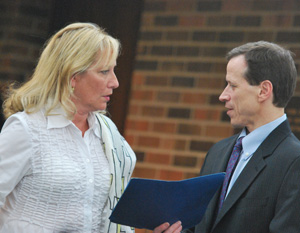
Regent Denise Ilitch talks with Tim Slottow, the university's CFO, prior to the start of the June 17 board of regents meeting. Ilitch voted against tuition and fee increases, as well as the overall budget for FY 2011.
Citing the challenges of Michigan’s economic crisis, Denise Ilitch argued against the tuition increase, saying that the university must solve its budget crisis from within, not on the backs of working-class families. She noted that she voted against increases last year, and would do the same this year. The university needs to be more innovative in finding ways to control escalating tuition. Michigan families are strapped, and with each dollar increase in tuition, the university limits the low- and middle-income students who can attend. The price of admission limits the economic diversity of the student body, she said. Ilitch acknowledged that the administration and regents have made progress, including more financial aid, a lower rate of tuition increase and an effort to cut costs – she noted that many executives at the table had foregone salary increases. “Yet we can do more, and we must lead by example.” It should not be the assumption that tuition is raised, she said, adding that the university saw new revenue this year that isn’t being passed on to students. Other universities have stepped up to control tuition, and UM should do the same. She said she’d keep prodding to make sure they did more.
Andrew Richner said he was happy and proud that his son will be one of the 6,000 or so freshman coming to UM in the fall. “I’ll be awarding him my own personal regents scholarship,” he joked. “I hope he appreciates it.” Richner said that’s why he has a very keen interest in this budget, and believes it balances the interests of affordability and accessibility, while preserving quality.
Libby Maynard said she would also be supporting the budget. She agreed with Darlow that it wasn’t an end game, but she felt that the budget preserved the quality of the institution.
Larry Deitch described the budget as restrained. He pointed out that regent Andrea Fischer Newman had been the first to advocate for endowing the general fund budget. He said he shared Ilitch’s passion for working families, and noted that no one worked harder than Darlow in coming up with a budget that balanced all of these interests. He planned to vote for the budget because they need to keep an eye on the long-term. Michigan is in the midst of an economic crisis, but they’ve lived through these before. And when the university celebrates its 200th anniversary in 2017, they’ll still be here, he said, leading the state and the world. They need to balance the needs of the people in the short term with the needs of the institution in the long term, Deitch said. The value of a quality education can’t be underestimated, he said, and unfortunately, it’s more expensive than they’d like it to be.
Votes on the Budget, Tuition, Fees
The board then voted on three budget-related items: 1) The university’s 2010-2011 revenue and expenditure operating budgets, which includes the general fund, designated fund, auxiliary activities and expendable restricted fund; 2) the Ann Arbor general fund operating budget; and 3) Ann Arbor tuition and fee rates.
The items passed, with dissent from Ilitch and Newman.
The budgets for the Flint and Dearborn campuses were presented separately. Both UM-Flint and UM-Dearborn had proposed a 3.9% increase in undergraduate tuition and fees, and a 2.9% increase in graduate tuition and fees.
Before the vote on these items, Newman commented that she would be supporting those increases, even though she had voted against lower tuition hikes for Ann Arbor. The reality is that the Flint and Dearborn campuses have less opportunity for bringing in new revenue, she said, compared to the Ann Arbor campus. The budgets from the three campuses aren’t intertwined, she noted, and Flint and Dearborn don’t get money from Ann Arbor. Newman said she was very aware of how important the general fund revenues were to Flint and Dearborn.
The tuition increases for UM-Flint and UM-Dearborn were approved, with dissent from Ilitch.
The board unanimously approved several fee assessments, which were not raised for the current year. They are, per student: 1) $7.19 to fund the Michigan Student Assembly; 2) $6 for Student Legal Services, 3) $1.50 for school/college student government organizations; and 4) $171.20 for the University Health Service.
UM Hospitals and Health Centers Budget
Doug Strong, CEO of the UM Hospitals and Health Centers, made a presentation on the FY 2010 budget, which ends June 30, as well as a budget plan for FY 2011. He began by noting that UM is the only health system in Michigan that serves people in every county throughout the state.
In looking ahead, he outlined some challenges and risks faced by the system, including a slow economic recovery and the impact of uncompensated care. There’s been a 17% increase in uncompensated care within the system in the past year, and a higher percentage of patients are being covered by government plans, including Medicare and Medicaid, which reimburse at lower rates than private insurers. Other risks include the consolidation in the industry – as other health care systems merge, that threatens UM’s referral base, he said. The state budget’s impact on the Medicare program is another concern, Strong said.
Completing the new C.S. Mott Children’s and Von Voigtlander Women’s Hospital is another challenge, Strong said, and they look forward to opening the facility in the fall of 2011. He also cited the uncertainties and impact of recently passed federal health care reform as a challenge the system will face.
Revenue for the current fiscal year is expected to reach $1.975 billion – next year, it’s expected to top $2 billion for the first time. This year’s operating surplus is expected to be $66 million, for an operating margin of 3.3%. Next year, the system is projecting a surplus of $83 million, for a 4% margin. The numbers for FY 2011 are premised on a nearly 6% increase in revenue, while keeping expenses down. Payroll for the coming year is projected to be $1.075 billion, up 4.6% from the current year.
Strong said the system remains financially strong, but needs to generate cash to invest in the future.
Vote on the UM Hospitals & Health Centers Budget
Regents had no questions or comments on the budget, which they unanimously approved.
Athletic Department Budget
The regents are not required to vote on the athletic department budget, but they heard a brief presentation by athletic director Dave Brandon. The department’s current cash flow is sufficient to sustain a healthy operating margin, he said, describing the budget as fairly conservative on the revenue side – they’re projecting $105 million in revenues for FY 2011, with $100.3 million in operating expenses. That leaves a projected operating surplus of $4.73 million. For the current fiscal year, which ends June 30, the department expects a $16.1 million operating surplus on $100.9 million in revenues.
Ticket sales account for the largest chunk of revenues – $38.19 million for FY 2011, including $32.5 million from football alone. Football revenues will take a hit because Michigan will have one fewer home football game this season, Brandon said, with only seven games played in Ann Arbor. This year, ticket sales brought in $38.26 million. An additional $11 million is anticipated from premium seating at Michigan Stadium.
The department expects to get $20.22 million in FY 2011 from Big Ten conference distributions, including $16.59 million from the TV broadcast of football and basketball games. This year, conference distributions accounted for $18.35 million in revenues.
Total debt – now standing at $175 million – has increased, Brandon said, primarily because of the Michigan Stadium construction project. The FY 2011 includes debt service payments of $9.226 million – $2.84 million in principal and $6.38 million in interest. The balance on the project as of June 2010 is $147.38 million. Two additional projects – Crisler Arena renovations and the adjacent Player Development Center – will increase debt to $215 million.
Endowment balances as of March 2010 stood at $56 million, Brandon said.
The FY 2011 budget includes a $1.5 million contingency line item, Brandon noted, which he said affords him the flexibility to restructure the department, as incoming athletic director. Brandon took over the job from Bill Martin earlier this year.
The athletic department budget also includes a $2 million transfer to the university’s need-based financial aid fund for non-athlete UM students. For the current year, the department transferred $1.6 million into that fund.
Construction, Facilities Projects
Regents approved several infrastructure-related projects, with no discussion. They include:
- $4.8 million for the annual Information and Technology Services maintenance and replacement program. Major project include replacing the networking infrastructure that supports the university’s data network, and upgrading the campus voicemail systems.
- A $56 million “deep” renovation of Alice Crocker Lloyd Hall, which is located on Observatory just south of Ann Street and houses about 560 students. Integrated Design Solutions LLC will design the project.
- A $1.6 million repair of Burton Memorial Tower, to be completed by the fall of 2011. The work will include repairs to the concrete and steel structure that supports the 55-bell, 12-ton carillon on the tower’s 10th floor – the carillon will be silenced during the project. In addition, workers will replace and waterproof the bell chamber floor, and replace the transmission system on bells affected by the structural work. This is only the second time that the carillon has been silenced in the tower’s 75-year history – the first time was in 2006, when a pair of peregrine falcons were spotted in the tower. Tim Slottow, UM’s CFO, told regents that workers would take care to accommodate the falcons. The engineering firm of Simpson Gumpertz & Heger Inc. will design the project, which also includes exterior work.
- A $1.7 million renovation of the molecular beam epitaxy (MBE) lab in the Carl A. Gerstacker Building at the College of Engineering. MBE is a procedure used in the design and manufacture of semiconductors, photovoltaics, and other devices.
In addition, regents acted on seven conflict-of-interest items. State law requires that regents vote on potential conflict-of-interest disclosures related to university staff, faculty or students. The items typically involve technology licensing agreements or leases, but cover other issues as well. This month’s batch, for example, included disclosure of plans by UM’s Office of New Student Programs to buy beverage break service during parent orientation sessions from Thayer Street Ventures. The item required a vote because Mark G. Pavach, a UM Health System employee, is a partner of Thayer Street Ventures.
There was no discussion of any of these items, which were all unanimously approved.
Additional Misc. Approvals
Regents unanimously approved several other items, without comment. They include:
- A new School of Nursing degree program – the doctoral of nursing practice.
- Renewal of the interlocal agreement for the Washtenaw Community Health Organization, a joint effort between UM and Washtenaw County. [The agreement has previously been approved by the Washtenaw County board of commissioners at their June 2 meeting.]
- The FY 2011 business plan for the Michigan Health Corp., a nonprofit entity that’s part of the UM Health System.
- Establishing a new regental committee on health affairs. Currently, there are two regental committees: the finance, audit and investment committee; and the personnel, compensation and governance committee.
Farewell to Teresa Sullivan
Earlier in the meeting, regents honored Teresa Sullivan, who was attending her last meeting as UM provost and executive vice president for academic affairs. In opening remarks, president Mary Sue Coleman noted that Sullivan is at the heart of the budgeting process, and expressed deep gratitude for her leadership, acumen and counsel. Coleman also highlighted Sullivan’s sense of humor, “which is more than required in her position.”
Regent Andy Richner, citing the budget challenges that the university has faced over the past few years and its ability to manage them well, joked that they are now “victims of our own success – we’ve lost our provost.” Sullivan has been appointed as president of the University of Virginia, starting Aug. 1. She’s leaving UM at the end of June.
Richner read a resolution in her honor, which highlighted her role in identifying funding for the hiring of 100 new tenure-track faculty, developing a systematic process of reviewing capital projects within the schools and colleges, and establishing task forces on cost reduction and revenue enhancements, among other achievements.
In thanking regents, Sullivan said that she and her husband, Doug Laycock – a UM law professor – “have enjoyed every day in Ann Arbor.” She thanked the board, her colleagues and staff. Regents and others in the boardroom gave her a standing ovation.
Public Commentary
Renee Echols was the only person to speak during the public commentary portion of the meeting. Identifying herself as a doctoral candidate and secretary for the Graduate Employees Organization, Echols told regents in the coming year the GEO will be entering contract negotiations with the university, as they do every three years, and they’d be coming to the regents to bring up issues related to that.
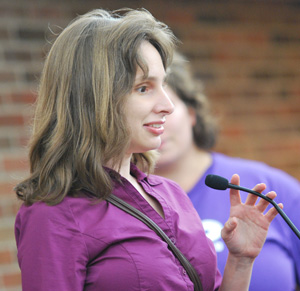
Renee Echols, an officer in the Graduate Employees Organization (GEO), spoke to regents during public commentary.
One concern is the issue of accessibility and accommodations for graduate student instructors with disabilities – she noted that she is visually impaired. The university has an excellent system of accommodation for students, she said, but that doesn’t extend to graduate instructors. When accommodations are requested from a department, they are usually turned down, she said, mainly due to a lack of understanding of what constitutes a reasonable accommodation.
In their upcoming contract negotiations, the GEO hopes to propose some procedures to help solve this problem, Echols said. Specifically, they’d like to develop concrete processes by which graduate instructors can request accommodations through their departments.
Denise Ilitch asked Echols for examples of requests that had been turned down. Echols said she’d twice been turned down for a request to have an assistant in the classroom to help during a course she was teaching. Other graduate instructors with chronic pain issues had requested a specific type of chair to use while teaching – those requests had been turned down, too.
Julia Darlow expressed concern, and asked the university’s general counsel, Suellyn Scarnecchia, whether graduate student instructors were considered as employees under the Americans with Disabilities Act. Scarnecchia said this issue hadn’t been brought to her office yet, and they’d follow up on it. It’s not just a matter of contract negotiations, she said – there’s a lot of law that applies to these issues.
Libby Maynard said the issues that Echols raised are essential to making the university what they want it to be – an inclusive institution.
Present: Mary Sue Coleman (ex officio), Julia Darlow, Larry Deitch, Denise Ilitch, Olivia Maynard, Andrea Fischer Newman, Andy Richner, Martin Taylor, Kathy White.
Next board meeting: Thursday, July 15, 2010 at 3 p.m. in the Fleming Administration Building, 503 Thompson St., Ann Arbor. [confirm date]




